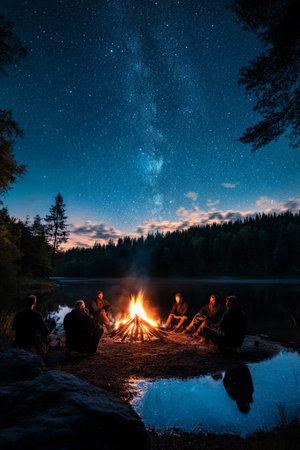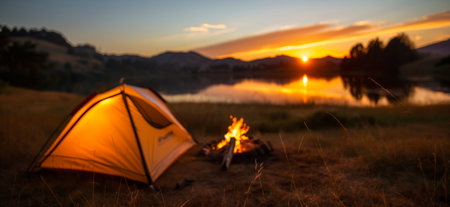Understanding Common Camping Emergencies
Camping in the United States offers an incredible way to connect with nature, but it also presents unique risks—especially for first-timers. Being prepared starts with knowing the types of emergencies you might face. Some of the most frequent issues include injuries like cuts, burns, or sprains, which can happen during hiking or around the campfire. Severe weather is another major concern, as sudden storms, extreme heat, or cold snaps can turn a peaceful trip into a dangerous situation if you’re not ready. Encounters with wildlife, such as bears or snakes, are rare but require careful handling and knowledge of local species. Lastly, getting lost is a real risk in unfamiliar terrain, particularly in larger national parks or remote backcountry areas where cell service may be limited. By understanding these common camping emergencies, you’ll be better equipped to handle them calmly and safely if they arise.
Basic First Aid and Safety Gear to Pack
Before heading out on your first camping trip, being prepared with the right first aid supplies and safety gear is essential for handling emergencies. Accidents can happen anywhere, but when youre out in nature—miles from the nearest hospital or urgent care—it pays to be ready. Below youll find a quick-reference table outlining must-have items every camper should pack, along with their uses in an emergency.
| Item | Purpose | How to Use in an Emergency |
|---|---|---|
| First Aid Kit | Treat minor injuries | Clean wounds, apply bandages, treat cuts, scrapes, or burns |
| Antiseptic Wipes/Ointment | Prevent infection | Disinfect wounds before bandaging |
| Adhesive Bandages & Gauze Pads | Cover and protect wounds | Apply to stop bleeding and keep dirt out of cuts or blisters |
| Tweezers & Scissors | Remove debris/ticks; cut tape or clothing | Extract splinters, remove ticks safely, trim gauze or tape to size |
| Pain Relievers (Ibuprofen/Acetaminophen) | Reduce pain and inflammation | Treat headaches, sprains, minor aches or fever until professional help arrives |
| Instant Cold Packs | Reduce swelling from sprains or insect bites | Activate by squeezing; apply to affected area wrapped in cloth if possible |
| Emergency Blanket (Mylar) | Treat shock or prevent hypothermia | Wrap around person to retain body heat if cold or in shock after injury |
| Whistle & Flashlight (with extra batteries) | Signal for help; see at night | Use whistle to attract attention; flashlight for visibility during nighttime emergencies or power outages |
| Duct Tape & Multi-tool/Knife | Patching gear; versatile fixes; cutting tasks in emergencies | Duct tape can create splints, patch tents, or hold bandages in place; multi-tool can cut rope, open cans, or assist with first aid needs |
Why Being Prepared Matters
Packing these essentials isn’t just about checking a box—it’s about giving yourself the ability to stay calm and respond quickly if something goes wrong. In American campgrounds and wilderness areas, cell service can be unreliable, so self-sufficiency is key. Always make sure your kit is stocked before every trip and that you know how to use each item. If you’re unsure about basic first aid techniques like treating burns or making a splint, consider taking a short community class offered by local organizations such as the American Red Cross.
Pro Tip: Customize Your Kit for Your Group and Destination
Your kit should reflect the size of your group and any special medical needs (like allergy medications or EpiPens). Also consider regional risks—such as snake bite kits for desert areas or extra insect repellent for buggy lakesides.
Remember:
The best emergency response starts long before you need it—with thoughtful preparation and practice using your gear. Make these basics a non-negotiable part of your camping checklist to ensure a safer adventure for everyone involved.

3. Staying Calm and Assessing the Situation
When you encounter an emergency during your first camping trip, your initial reaction can make a huge difference in the outcome. It’s completely normal to feel anxious, but staying calm is crucial for both your safety and the well-being of your group. Take a deep breath and give yourself a moment to process what’s happening. This helps prevent panic from taking over and allows you to think more clearly. Start by evaluating the scenario: Is anyone hurt? Is there immediate danger from wildlife, fire, or weather? Use your senses—look around, listen for unusual sounds, and check for any hazards nearby. Try to keep your voice steady when talking to others, especially if you’re with kids or less experienced campers; your composure will reassure them.
Quick Strategies to Stay Composed
- Ground yourself: Focus on slow, deep breaths and remind yourself that panicking won’t help.
- Delegate tasks: If you’re with others, assign simple jobs like gathering supplies or checking on everyone’s location. This creates structure and helps keep people busy rather than fearful.
- Use positive self-talk: Tell yourself you can handle this situation—it’s surprising how much mindset matters in emergencies.
Evaluating the Scenario Effectively
Once you’ve calmed down, systematically assess the emergency. Ask yourself: What exactly happened? Who is affected? What resources do we have—like a first aid kit or communication devices? Prioritize immediate dangers, such as injuries or threats from animals or weather. Make sure everyone in your group is accounted for and safe before making further decisions.
Avoiding Panic
Panic spreads quickly in groups, so focus on clear communication. Speak slowly, explain what’s happening, and outline the next steps. Avoid rumors or guessing—stick to facts. Remember, emergencies are stressful but manageable when you remain level-headed and take things one step at a time.
4. Reaching Out for Help in Remote Areas
When you’re camping far from civilization, reaching emergency services quickly can be a real challenge—especially if your cell phone has no signal. Knowing how to alert others and communicate your location is crucial for first-time campers facing urgent situations.
Best Ways to Contact Emergency Services
If you have cell service, always try dialing 911 first. In the U.S., 911 operators can often triangulate your position even if you can’t speak clearly. If calls fail, try sending a text message to 911, as texts sometimes go through when calls don’t. For added safety, consider carrying a satellite phone or a personal locator beacon (PLB), both of which can function without cell towers.
Using Signaling Tools Effectively
It’s smart to pack signaling devices before heading out. Whistles, signal mirrors, brightly colored tarps, and even flashlights can help rescuers locate you. Three loud whistle blasts or flashes are recognized as an international distress signal. During the day, a mirror reflecting sunlight can catch the eye of search planes or hikers; at night, use a flashlight or glow sticks for visibility.
Communicating Your Location
If you manage to reach help, provide clear details about your surroundings. Use natural landmarks, GPS coordinates from your phone or device, and note any trail markers nearby. Make sure someone back home knows your planned route before your trip—it could make all the difference if you need to be found.
Emergency Communication Methods Comparison
| Method | Works Without Cell Service? | Pros | Cons |
|---|---|---|---|
| Cell Phone Call/Text | No (unless texting works with minimal service) | Easy and familiar | Not reliable in remote areas |
| Satellite Phone | Yes | Works almost anywhere | Expensive; needs charging |
| Personal Locator Beacon (PLB) | Yes | Sends SOS with location data to rescuers | No two-way communication; pricey upfront cost |
| Whistle/Signal Mirror | Yes | No batteries needed; lightweight | Relies on being within sight or hearing range of others |
Pro Tip:
Always keep signaling tools easily accessible in your backpack or on your person—not buried at the bottom of your gear. In an emergency, every second counts!
5. Handling Specific Scenarios
Step-by-Step Guidance for Common Camping Emergencies
Dealing with Injuries
1. Stay Calm and Assess the Situation
If someone gets hurt, take a deep breath to steady yourself before taking action. Check for dangers around you and make sure the area is safe.
2. Provide Basic First Aid
For cuts or scrapes, clean the wound with clean water and cover it with a sterile bandage. For sprains or strains, remember R.I.C.E.—Rest, Ice, Compression, Elevation. If bleeding is severe, apply firm pressure and seek help immediately.
3. Call for Help if Needed
If the injury is serious (broken bones, head injuries, trouble breathing), use your phone or send someone to get help. Know the nearest location where you can get cell service in advance.
Handling Animal Encounters
1. Keep Your Distance
If you spot wildlife like bears or snakes, stay calm and never approach or try to feed them. Back away slowly while facing the animal.
2. Make Noise and Stand Tall
If an animal comes close to your campsite, make yourself look bigger and make loud noises to scare it off—never run away suddenly as this can trigger a chase.
3. Secure Food and Trash
Always store food in bear-proof containers or hang it from a tree away from your tent. Dispose of trash properly to avoid attracting animals.
Coping with Sudden Weather Changes
1. Monitor Weather Updates
Check weather forecasts before heading out and bring a portable weather radio or smartphone to keep updated on sudden changes.
2. Seek Shelter Immediately
If you notice dark clouds, strong winds, or hear thunder, head for shelter right away—either your tent (if its safe) or your vehicle if lightning is nearby.
3. Stay Warm and Dry
If rain hits unexpectedly, put on waterproof layers and move gear under cover. In cold snaps, add extra insulation and avoid getting wet to prevent hypothermia.
Preventative Measures and Planning Ahead
When it comes to staying safe while camping for the first time, preparation is everything. Before heading out, do your homework on the campsite—check weather forecasts, research local wildlife, and read recent reviews from other campers to be aware of any current hazards. It’s smart to pack a comprehensive first aid kit, know how to use it, and bring extra supplies like batteries, water purification tablets, and backup food.
Get Familiar with Your Campsite
Familiarize yourself with the campsite layout by reviewing maps online or calling ahead to ask about emergency procedures and nearest help stations. Make a mental note of the closest hospital or ranger station and mark these locations on your map or phone in case you lose service.
Prepare an Emergency Plan
Always share your camping itinerary with a trusted friend or family member who is not going on the trip. Establish check-in times so someone knows if you’re overdue. Within your group, designate meeting points and discuss what everyone should do in case you get separated.
Packing Smart: What You Need
Bring more than just the basics—think multi-tool, whistle, flashlight with extra batteries, rain gear, and copies of important documents sealed in waterproof bags. Also, carry a printed list of emergency contacts and any medical information that could be crucial if someone needs help fast.
By taking these preventative measures and planning ahead, you’ll minimize risks and ensure that you’re better equipped to handle unexpected situations. Remember, being prepared isn’t just about gear—it’s about knowledge, communication, and confidence.


